This week’s economic calendar is the lightest in recent memory. After Monday, FedSpeak fans will be disappointed, since we are entering the quiet period before the next FOMC meeting.
Like nature, pundits abhor a vacuum. To fill it they will be asking:
Is the weak employment report big news for stocks?
Last Week
Most of the economic news was fine – until Friday morning! The weak employment report—widely viewed as the most significant economic data of the month—clearly changed the market perspective. Astute market observer Eddy Elfenbein described the instant market sector rotation from financials (which I like) to utilities (which I hate). This is going to change, but what it will take is a key question.
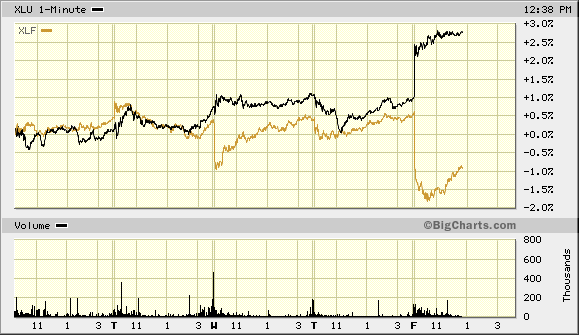
Theme Recap
In my last WTWA, I predicted that the big discussion would be about the risk/reward for stocks and possible breaking of the recent trading range. That did get some attention – at least as much as anything else other than politics – until Friday morning. New highs now seem to be on hold.
The Story in One Chart
I always start my personal review of the week by looking at this great chart from Doug Short. He has a special knack for pulling together all of the relevant information. His charts save more than a thousand words! Read his entire post about the S&P 500 where he adds analysis and several other charts providing long-term perspective.
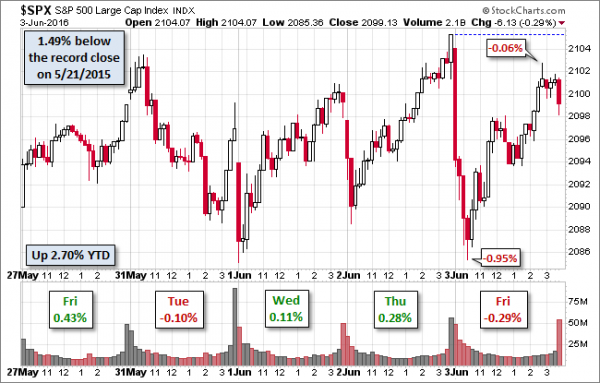
Special News
Abnormal Returns is one of our regular sources and references, helping all of us on many occasions. This week Tadas is supporting a great cause, charity: water. Check out the description at Abnormal Returns, where you can either purchase T-shirts with the new logo, or join me in making a direct contribution.
Please also be sure to check out the special offer at the end of today’s post – a reader opportunity that I have sought for many months.
The News
Each week I break down events into good and bad. Often there is an “ugly” and on rare occasions something really good. My working definition of “good” has two components. The news must be market friendly and better than expectations. I avoid using my personal preferences in evaluating news – and you should, too!
The Good
- ADP private employment report showed a solid gain of 173K, and the prior month was revised higher.
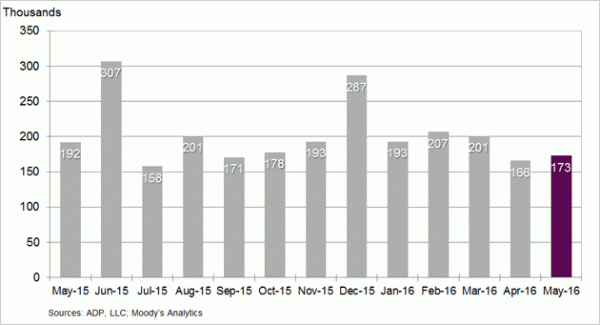
- ISM manufacturing continued expansion and beat expectations at 51.3. Scott Grannis puts this in perspective. New Deal Democrat suggests that it marks the end of the “shallow industrial recession.”
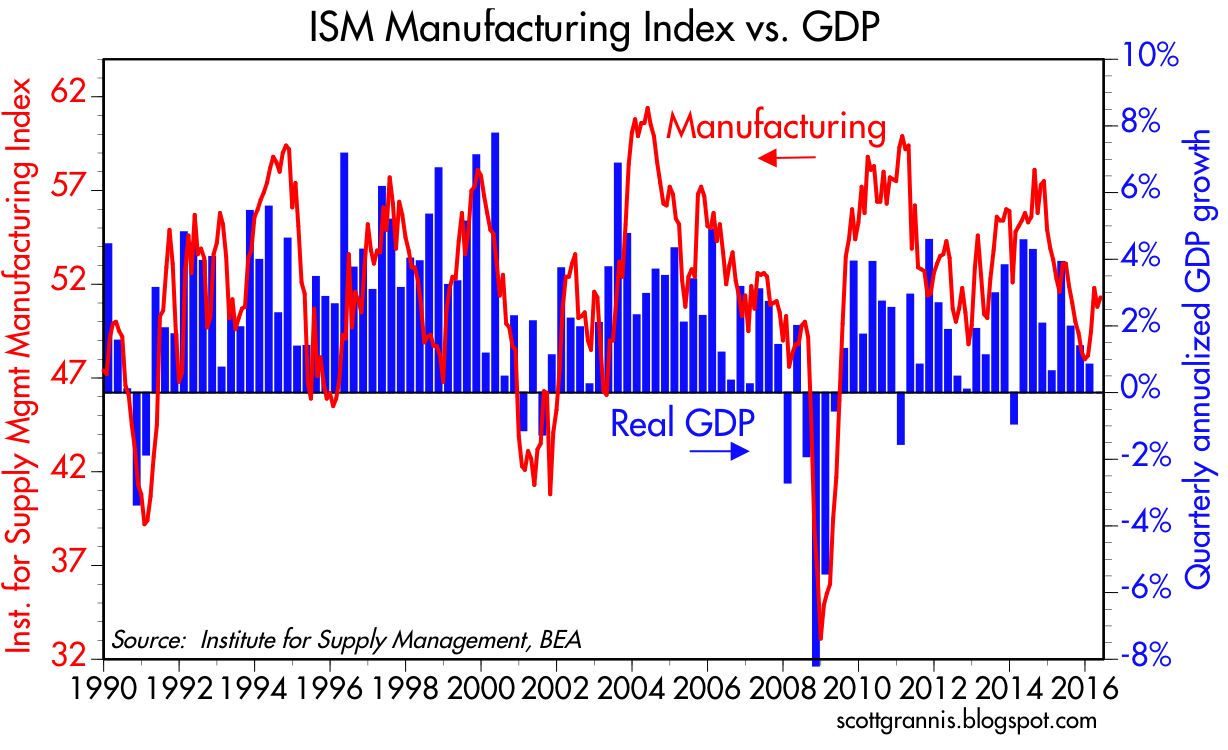
- The Fed’s Beige Book showed overall economic improvement. Steven Hansen reports (but does not show much enthusiasm for the news).
- Wage growth is improving. The Atlanta Fed report came before Friday’s news, but presumably it will get even better.

- Sentiment remains negative, and that is a positive for stocks. The Bespoke Premium service (check it out!) provides this chart:
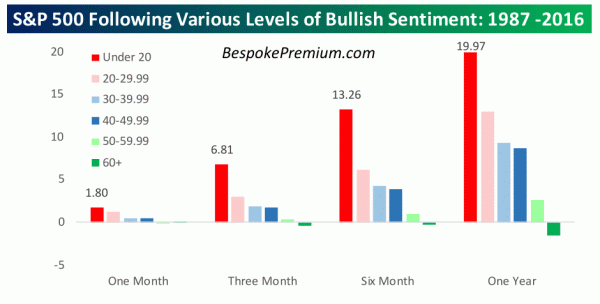
The Bad
- Consumer confidence (via the Conference Board) declined from the prior month (92.6 vs 94.7) and also missed expectations. I regard consumer confidence as important, so declines are worrisome.
- Auto sales disappointed. Trucks and SUVs were strong, but passenger cars very weak. The WSJ has a good report.
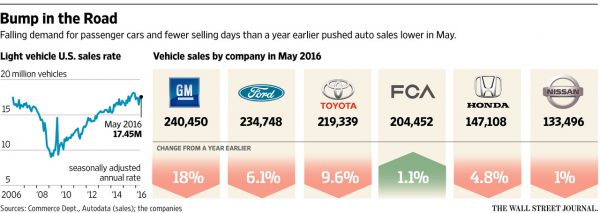
- The yield curve is flattening. Dr. Ed asks if this is a “global yellow light.”
- Employment growth weakened. By all measures, and despite the deceptive decline in unemployment, the May employment situation report disappointed. The WSJ has a collection of reactions from economists. Conclusion: A dud! Business Insider has a similar compendium. Some highly respected sources suggested that the results were even weaker – perhaps a negative number – if the seasonal adjustments were accurate. The following chart is from the BLS report:
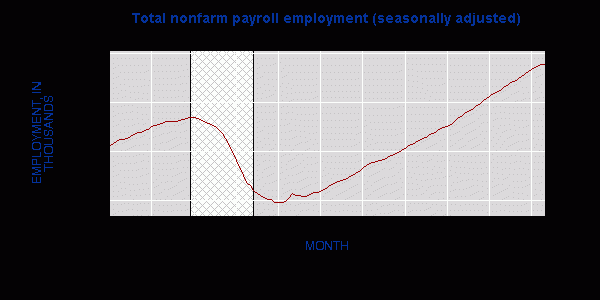
The Ugly
Defective air bags. Bloomberg’s feature story, Sixty Million Car Bombs: Inside Takata’s Air Bag Crisis, describes the story behind the development and sale of a product that proved to be dangerous. Warnings from some within Takata (OTC:TKTDY) were not heeded. The company denies that “data integrity problems” revealed in documents from the U.S. Senate investigation were directly related to air bag ruptures. This is a fascinating article that shows the temptation to cut corners when big profits are at stake. It will take three years to replace all of the defective air bags.
The Silver Bullet
I occasionally give the Silver Bullet award to someone who takes up an unpopular or thankless cause, doing the real work to demonstrate the facts. Think of The Lone Ranger. No award this week. Nominations are always welcome!
The Week Ahead
We would all like to know the direction of the market in advance. Good luck with that! Second best is planning what to look for and how to react. That is the purpose of considering possible themes for the week ahead. You can make your own predictions in the comments.
The Calendar
We have an extremely thin week for economic data. I highlight only the most important items, helping us all to focus.
The “A” List
- Michigan sentiment (F). Information about consumption and job creation you can’t get elsewhere.
- Initial claims (Th). The best concurrent indicator for employment trends.
The “B” List
- JOLTS Report (W). Mostly misinterpreted. Not an indicator for job growth, but rather the labor market.
- Wholesale inventories (Th). Has impact on Q2 GDP.
- Crude inventories (W). Often has a significant impact on oil markets, a focal point for traders of everything.
A Monday appearance by Chair Yellen will have an impact before noon, setting the context for the rest of the week. There is a little other FedSpeak, but we are entering the quiet period before the next meeting.
Brexit news will also grab attention.
Next Week’s Theme
It is a very light calendar. Like nature, pundits abhor a vacuum! There are pages to paint with pixels and airtime to fill with opinion. The space available is always about the same, even if the need is reduced. CNBC has gone to reality TV and features at night, and it is creeping into the daily schedule. My solution of TIVO and mute is a good way to avoid the reports on the stress in the nine-figure real-estate market and whether the latest blip in some indicator should change my market attitude.
You will learn more watching those good ol’ boys from West Texas!
My exasperation… [Mrs. OldProf noted my jaw setting and reminded me to restrict my opinions to the conclusion. Thanks to her and please check there.)
Friday’s employment report seemed sharply different from other recent economic news. The key question for the week will be:
Is the weak employment report big news for stocks?
There are four promising themes for speculation:
- Is the employment data the best read on economic growth?
- Will the weak report influence Fed policy?
- Does Fed policy really matter?
- Will market perceptions be more important than any of the factual questions?
The super-bearish opinions will emphasize the weak economy, the Fed is in a box (corner, rock-and-hard-place or whatever) and needs to hike rates regardless of conditions.
The mainstream is expecting Chair Yellen to dial back, if only because of market perceptions. We will get our first clue about the Fed on Monday.
Quant Corner
We follow some regular great sources and also the best insights from each week.
Risk Analysis
Whether you are a trader or an investor, you need to understand risk. Risk first, rewards second. I monitor many quantitative reports and highlight the best methods in this weekly update.
The Indicator Snapshot
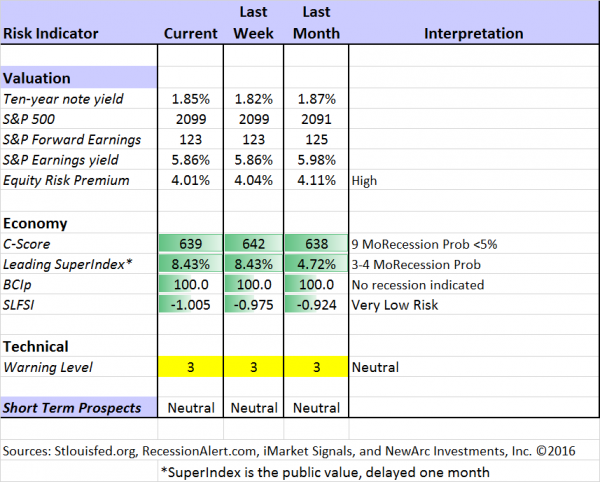
The Featured Sources:
Doug Short: The Big Four Update, the World Markets Weekend Update (and much more).
Brian Gilmartin: Analysis of expected earnings for the overall market as well as coverage of many individual companies. This week he expresses more confidence about growth in earnings.
Bob Dieli: The “C Score” which is a weekly estimate of his Enhanced Aggregate Spread (the most accurate real-time recession forecasting method over the last few decades). Monthly reports including both an economic overview the economy and employment. After each employment report Bob Dieli provides a complete, balanced, “no-spin” analysis. Here is a typical chart from this week’s report:
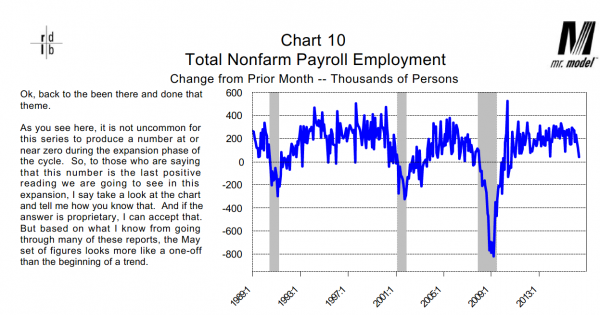
RecessionAlert: Many strong quantitative indicators for both economic and market analysis. While we feature the recession analysis, Dwaine also has a number of interesting approaches to asset allocation.
Georg Vrba: The Business Cycle Indicator, and much more. Check out his site for an array of interesting methods. His latest update features his unemployment rate recession indicator. A recession is unlikely “any time soon.”
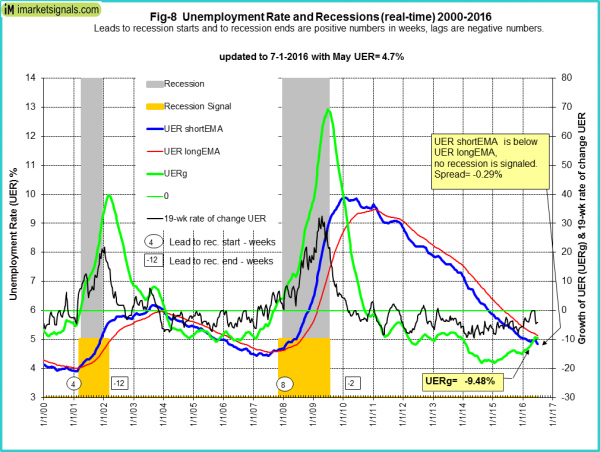
Holmes: Our cautious and clever watchdog, who sniffs out opportunity like a great detective, but emphasizes guarding assets.
How to Use WTWA
In this series I share my preparation for the coming week. I write each post as if I were speaking directly to one of my clients. For most readers, they can just “listen in.” If you are unhappy with your current investment approach, we will be happy to talk with you. I start with a specific assessment of your personal situation. There is no rush and no cookie-cutter approach. Each client is different, so I have six different programs ranging from very conservative bond ladders to very aggressive trading programs. A key question:
Are you preserving wealth, or like most of us, do you need to create more wealth?
My objective is to help all readers, so I provide a number of free resources. Just write to info at newarc dot com. We will send whatever you request. We never share your email address with others, and send only what you seek. (Like you, we hate spam!) Free reports include the following:
- Understanding Risk – what we all should know.
- Income investing – better yield than the standard dividend portfolio.
- Felix and Holmes – top artificial intelligence techniques in action.
- Why 2016 – The Year of the Value Stocks – finding cheap stocks based on long-term earnings.
You can also check out my website for Tips for Individual Investors, and a discussion of the biggest market fears. (Please send any questions or suggestions for new topics.)
Best Advice for the Week Ahead
The right move often depends on your time horizon. Are you a trader or an investor?
Insight for Traders
We consider both our models and also the best advice from sources we follow.
Felix and Holmes
We continue our neutral market forecast. Felix is fully invested, and continues with fairly aggressive sectors. Most sectors remain in the penalty box. The (usually) more cautious Holmes is almost fully invested, with fifteen positions. Holmes uses a universe of nearly 1000 stocks, selected mostly by liquidity. Even when the overall market is neutral, there will often be some strong candidates. That is what we see now. It is not a resounding endorsement of the overall market, but a vote for opportunistic trading.
Top Trading Advice
Adam H. Grimes has some great advice on trading a quiet market. So many traders go wrong in such times. Of his five points, I especially like the last:
Quiet markets are boring, but focus is rewarded. No one wants to talk about some market that is sitting in a 2% range for weeks, and the media quickly loses interest when markets go into consolidation. You, as a trader or investor, cannot. No one is going to do this work for you. It’s hard work to maintain focus when that focus is not rewarded today, tomorrow, or even next week, but you must do so. Know where the opportunities are, and monitor market conditions for shifts that might mark significant inflections. For some traders, a daily look at a handful of markets is enough, but other traders might consider setting alerts or using other screening tools.
Dr. Brett has another great contribution that most traders have never considered. The language we embrace to describe markets colors are thinking and prevents flexibility. He writes:
The traders I see making money are employing language differently to make sense of frequently-changing markets. For example, several traders I know are trading shorter-term strategies and longer-term strategies and adjusting the weighting of those based upon how markets are moving. A good example was yesterday’s trade in the ES futures. We had early selling off the weak jobs number, but many sectors of the market displayed buying interest. The advance-decline line was unusually strong, given the decline in the average, and we never hit a selling extreme of -800 or less in the NYSE TICK measure. This was a useful tell that the selling was part of sector rotation, not part of a general bear/risk-off move. Recognizing this made it much easier to take profits on short positions early in the day and not get whipsawed by the afternoon strength.
In a topic that has broad interest, Bloomberg’s Sheelah Kolhatkar asks why Phil Mickelson did not get busted for insider trading. When I was teaching new traders at the Chicago options exchange, one of my first classes was to bring in a legal expert on this topic. Information flowed wildly – in the rest rooms and elevators, but most of it was wrong or unhelpful. Meanwhile, if something worked, what was the risk?
Needless to say my companies and students never used such information and they all understood why. Traders need to know about this. Did you hear about the plumber who got a tip from a top executive? Free bathroom remodeling? Sheesh!
Insight for Investors
Investors have a longer time horizon. The best moves frequently involve taking advantage of trading volatility!
Best of the Week
If I had to pick a single most important source for investors to read, it would be Chuck Carnevale’s warning about buying over-valued stocks. He carefully points out how even good companies can be poor stock purchases if the price is too high. I cannot agree more. As part of our stock screening we always use Chuck’s tools, and you should, too! Here are some examples of good companies at bad prices.
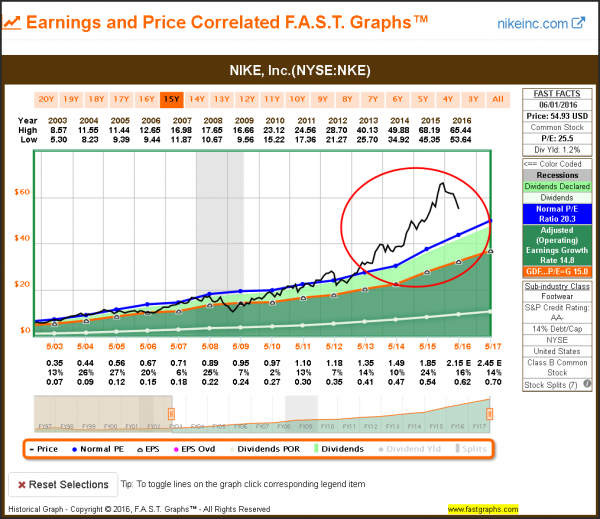
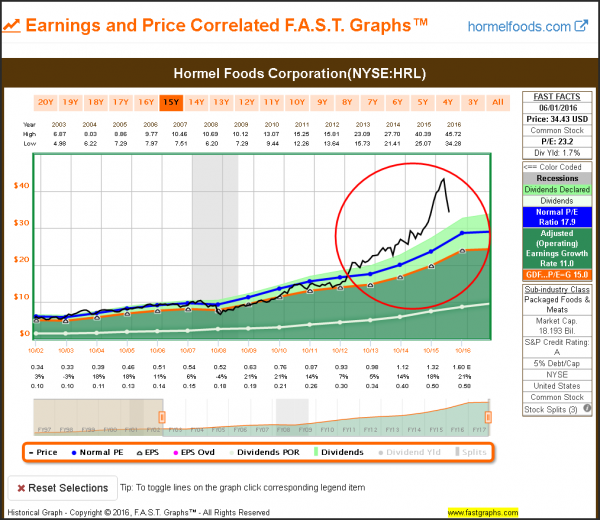
The full article has more examples as well as some current “buy” ideas.
Stock Ideas
Here is an update on Morningstar’s ultimate stock pickers. These reflect “conviction buys” which are new or large positions from top managers. The information lags a little, but no one is “talking his book.”
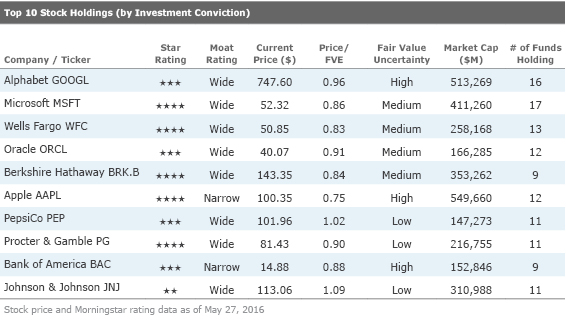
Personal Finance
Professional investors and traders have been making Abnormal Returns a daily stop for over ten years. The average investor should make time (even if not able to read AR every day as I do) for a weekly trip on Wednesday. Tadas always has first-rate links for investors in his weekly special edition. There are always several great choices worth reading, but my favorite this week is from Larry Siegel, the Gary P. Brinson Director of Research for the CFA Research Foundation. He takes on a difficult but important topic – the expected return from various asset classes. A recent study by the McKinsey Global Institute has attracted plenty of attention, mostly because of the downbeat forecasts. The range of factors is apparent from this fascinating deconstruction of all that goes into determining equity returns. It is taken from the original study and repeated by Siegel to assist in the analysis.
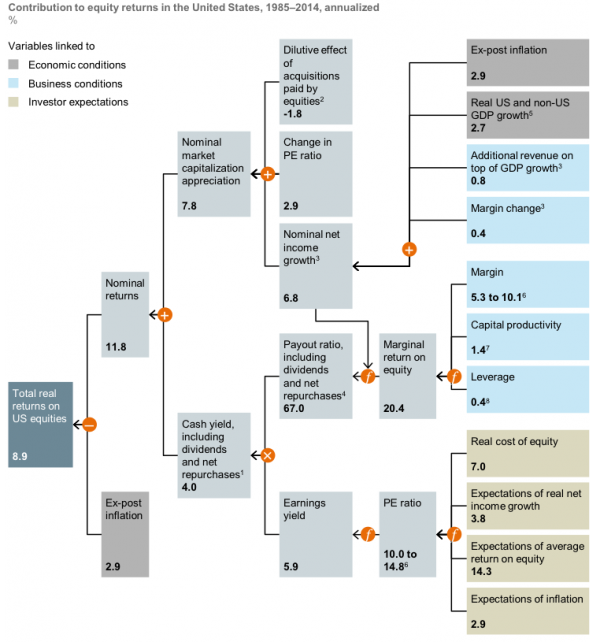
You need to read the entire article to understand this, but it is worth the effort. Here is his conclusion:
Investors who expect a miracle from the markets – who think that 3% or 5% savings rates will get them close to their goals or that 10% savings rates will assure them a luxurious future – will be disappointed. Those conditions never existed. One would have had to have perfect foresight – and a lot of money early in life – to buy at the bottom in 1982 and then never sell until the top in 2000 or 2007 or 2015, availing oneself of the full glory of the largest bull market in history.
But investors who save diligently, buy and hold diversified portfolios of stocks and bonds and focus on their very long-term goals will do fine. A bias toward equities is justified, given the exceedingly low expected returns on bonds. Even with growth as low as we’ve experienced over the disappointing period since the end of the global financial crisis, the equity risk premium implied by McKinsey’s forecasts is 4%, enough to justify an above-average allocation to equities. With higher growth rates, the equity risk premium implied by McKinsey’s forecasts is even higher: 4.5%.
Dividend Stocks
Is it time for a stress test?
Energy Stocks
Our best source on the economics of the energy markets is Prof. James Hamilton. His update this week is worth careful reading by anyone interested in oil prices or energy stocks. Since there has been such a high correlation between oil prices and U.S. stocks (the bogus economic proxy), we are all forced to be interested. This chart from his excellent article is worth special attention:

Watch out for….
The Brexit threat. Polls put the vote (June 23rd) at 50-50. The bookies make it 30% in favor. This is a threat worth watching, since good studies suggest a major hit to exports if it passes. (Econbrowser). Two questions remain:
- How much of this is already anticipated?
- How much will extend to the rest of the world?
Marc Chandler cites three political events before the vote.
Expect more on this topic next week.
Some net-lease REITs. Brad Thomas explains what to look for as well as three to avoid.
Final Thoughts
How much did Friday’s employment news change the fundamental picture of economic growth? Or the prospects for stocks?
Not very much.
There are three key points:
- Any single report is of marginal significance – even employment.
A single employment report is but one flawed indicator of what is happening. It carries such significance not because it is especially accurate, but because we would really like to know the answer!
[picking up from above] My exasperation hit a peak Friday morning when the pundit-in-chief complained about revisions in the employment report. I was astounded to realize how little he knew about how the information was collected and compiled. As Cramer himself would put it: “HE KNOWS NOTHING.” Why does he think Fed economists would have fewer revisions? Sure we can track a package across the county. Should we all wear a bar code? We have excellent data with an eight-month lag. Getting data monthly is difficult and costly. (Should have kept the mute on!)
There is a huge margin of error on the net job growth (+/- over 100K) as well as the various subcategories. This is sampling error — after all revisions. Some companies never respond to the survey. Historically the growth of new businesses replaces those that drop out – plus a little more. I have explained this many times, most recently here, but you never see it mentioned by the punditry. The temptation to discuss pseudo-facts is just too juicy.
There are several estimates of employment growth, including the ADP, that are just as good and perhaps even more accurate than the BLS approach.]
- The Fed understands point #1. They have 350 expert economists who do not need to pontificate on TV. They understand surveys, sampling, birth/death models, and alternative methodologies. They place much less emphasis on a single number than the market.
- Nevertheless, the Fed does not want to surprise markets. Many recent Fed decisions have reflected not the best information, but the Fed guess about the market perception of information.
Everyone expects that a June rate increase is off the table, and probably July as well. The exact timing does not really matter, but I still expect two hikes before the end of 2016.
